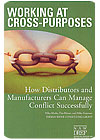
It was late in the research stage and early in the understanding phase when Mike Marks, Mike Emerson and I were discussing our findings. Two things were apparent: One, businesses in a supply chain worked at cross-purposes, even though they needed each other to succeed; and two, there was little evidence that the sugarcoated theory of “win-win” ever helped either party achieve any significant wins.
The questions we tossed around the table that day were not concerned with the validity of the findings, it was whether or not senior managers would accept a frontal assault to their cherished beliefs. Win-win was part of the American business lexicon. Executives believed that if we all work together, we will all win and shared prosperity would be the result. Our research proved otherwise.
When we shared the initial findings with the board of directors of the Distribution Research and Education Foundation (DREF) and the underwriter of this project, they were encouraging. “This is what we want,” one board member commented, “something provocative, research-based and thought-provoking.”
With this encouragement, we continued working, writing and challenging our findings. With each rewrite, the truth became more obvious - suppliers and distributors should operate at cross-purposes. This was the only way for both to survive. We wanted to let executives at both the supplier and distributor level know that these cross-purposes were both explainable and legitimate.
We also wanted to develop some simple guidelines designed to help these same executives manage the conflicts that occur in a supplier-distributor relationship. There are many challenges that exist in managing a supplier-distributor relationship. The book,Working at Cross-Purposes: How Distributors and Manufacturers Can Manage Conflict Successfully, takes on most of them. It was published in June 2006 and is available from DREF atwww.naw.org/cross.

Challenges In Managing A Supplier-Distributor Relationship
In this short piece, I am going to explore a few of these challenges:- Understanding that “win-win” is a myth - but mutual success can still be a goal.
- Understanding the difference between critical issues and minor but aggravating ones (we call them MBAs).
- Understanding the importance of the local rep in the equation.
Exploding the win-win myth was especially provocative. As I mentioned earlier, it is such a stalwart cherished belief in American business that it is often accepted without question or investigation.
The truth is that win-win can often cause more harm than good. When executives believe that win-win exists and there is a shared prosperity, they start believing in entitlements. Entitlements don’t exist in today’s business; just ask the competitors of Wal-Mart who watched their long-standing suppliers cut prices and bend over backward for the giant retailer.
We realized we were onto something with our “win-win is dead” thesis when we presented our findings to a roundtable gathering of major manufacturers. One of the participants, upon hearing our thoughts, exclaimed, “Boy, am I glad to hear that - I always thought it was a bunch of bull. Finally, someone had the guts to say it out loud.”
We aren’t saying that there isn’t still an opportunity for mutual success. In fact, mutual success is important. However, it is easier to attain success when everyone realizes that cross-purposes are part of everyday business. When all was said and done, win-win led to false hopes and wasn’t a very effective way to manage a relationship.
If legitimate cross-purposes exist, conflicts also exist. They are inherent in the supplier-distributor relationships. In our research, we found ample evidence to support this belief. Suppliers want broad product representation and distributors want products that sell. Distributors want solid marketing plans and suppliers want dedicated sales teams. The list goes on and on.
One key to effectively managing these conflicts is to determine which are critical and which are minor. Our book offers guideposts to help supplier and distributor executives operate in a world of legitimate cross-purposes. Among the many guidelines is the important sixth rule: “Don’t overreact to MBAs.” Early in our research, we realized that high-performing organizations, intuitively or otherwise, recognized which issues needed their immediate attention and which issues simply fell into the MBA bucket. It is important to note that “minor but aggravating” issues can derail the strongest relationships.
Both distributor and supplier executives should tread cautiously when dealing with requests. What one party sees as trivial, another sees as critical. Many of these MBA requests come from the supplier rep, which brings me to my last topic of this article.
The supplier rep is a key cog in the wheel, but is generally under-trained and overworked. These reps are often the ones asked to deliver the bad news to their bosses on the supplier level and manage the ever-changing demands of their customers at the distributor level. They are usually in their positions for a short period and, just when they figure it out, they are promoted or transferred. They are critical to the success of the relationship, but are often the forgotten soldier when the relationship sours.
The rep position is usually filled with entry-level employees who are put in the trenches with a lack of ammunition, skill and experience. Yet, our research indicated that they are a very important factor in the relationship. Successful distributor executives understand this relationship is important and manage it effectively. For example, they will help a rep make goals and quotas, as long as they don’t influence the long-term success of the distributor organization. In fact, there were several instances in our research where the first-line distributor managers served as unofficial mentors to the local factory rep.
The first line of communication for most distributors is with this local factory representative. It is important to keep this line of communication open at all times. Our research indicated that many terminal conflicts between suppliers and distributors could have been avoided if the distributor executive would have looked to the factory representative for early warning signs.
Remember as you analyze your own supplier-distributor relationships, treat win-win as a myth. The concept is quaint and easy to embrace, but in the end doesn’t clearly define the complex relationships between suppliers and distributors. Legitimate cross-purposes exist, and it is better to accept and manage that they exist. When cross-purposes exist, some conflicts will be important; some will be MBAs. Learn to tell the difference and manage the conflicts accordingly.
And last, but not least, understand the plight of the local factory representative and manage the relationship carefully. The first opportunity for resolution of many supplier-distributor conflicts is with the factory representative. The ability to create a strong relationship resides with the distributor executive. Take advantage of the opportunity.
